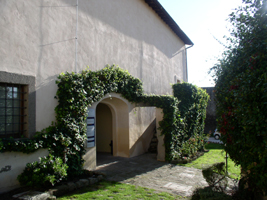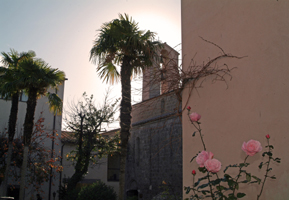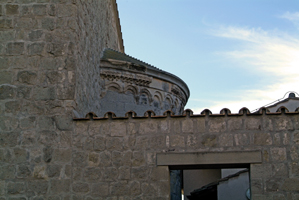
S. Maria in Gradi Complex
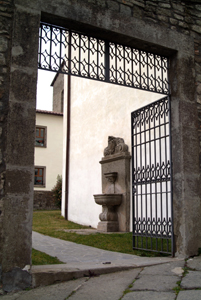
The Rectory and the Administrative Offices of the Universitą degli Studi della Tuscia di Viterbo are located in the complex of S. Maria in Gradi.
The complex of S. Maria in Gradi was for several centuries a Dominican convent. Erected in 1244 at the behest of Viterban Raniero Capocci, a papal notary, was salvaged after important restorations were conducted by the Universitą della Tuscia starting from 1996. The complex presents itself still imposing and rich with historical and artistic testimony. Among these, particular importance is represented by a cloister, dating back to the middle of the 13th Century, in which the original decorations are still legible in their entirety: five pentafore with pointed arches on each side, which rest on marble twin columns, 160 in all. Every column exhibits a beautiful gargouille with a lion’s head that, even though today lacks the original function of draining rainwater, constitutes a significant decorative element. At the center stands a well from 1557 (the date is engraved on the entablature), rested upon a base composed of tombstones recovered from the ancient church of S. Maria in Gradi.
In front of a cloister that remained almost intact for more than eight centuries, there is a second cloister, constructed in 1306, but reworked several times, that today displays severe 17th Century shapes. At the center, in this case, stands a fountain, constructed in 1480; classical in its structure, characterized however by an original octagonal “fence” surmounted by a classicist entablature of the Renaissance spirit.
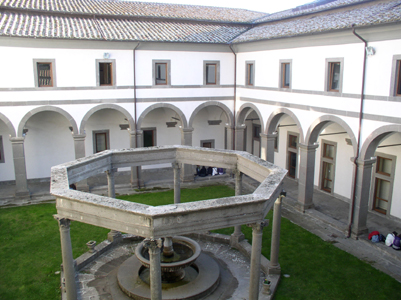
The entire complex has its fulcrum in that which remains of the imposing church of S. Maria in Gradi, founded in the second half of the 13th Century. The toponym of the location suggests that from the outset the church was characterized by an entry staircase (“ad gradus”). Reworked at the end of the 15th Century and then radically reconstructed in the middle of the 18th Century by the Roman architect Nicola Salvi, who also designed the Trevi Fountain, it had suffered obvious damage attributable to the bombings of WWII, to the collapse of the roof following the abundant snowfall in the winter of 1956, and to the state of desertion during the period in which the entire complex was converted into a prison (1873-1993).
Since July 2015 a space, in which parts consisting of the collections and of the museums of the University Museum System are exhibited, has been set up within the ancient locations of the Rectory (the former convent of 14th Century origins).
S. Maria del Paradiso Complex
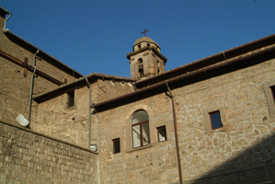
Today the location of the Faculty of Economics, the complex dates back to the first years of the 13th Century, when it was created to house the Cistercian monks. Originally the site housed a church dedicated to S. Michele, belonging to the monks of Farfa. After, it was a monastery for nuns, until the Franciscans settled there from the 15th Century until 1870.
The building was reworked so many times in the course of the next few centuries that the church very soon lost its 13th Century aesthetic. Nearly intact, however, is the stylistic reading of the cloister, in which it is possible to recover the evident historical vicinity with the contemporary loggia of the Papal Palace of Viterbo. There appear in fact the triple lancet windows composed of the characteristic pointed arches supported by double columns, interspersed with pillars, such as those in the papal loggia, in what remains of the cloister of the abbey of S. Martino al Cimino, in the medieval cloister of S. Maria in Gradi, and in that of the church of S. Maria della Veritą, today the Civic Museum. But the arches and the columns of S. Maria del Paradiso appear more serious and imposing.
The frescoes of the lunettes go back to the first half of the 17th Century, and are the work of Angelo Pucciati.
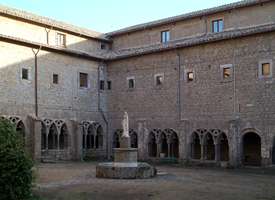
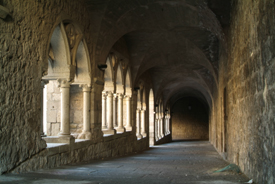
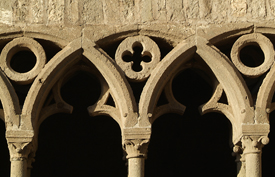
S. Carlo Complex
The location of the Faculty of Political Sciences, the complex in its various historical buildings, today restructured, originated from the ancient church of S. Nicola degli Scolari, which from documents from 1152 proved dependent on the abbey of Farfa. Remaining from the ancient building are the bell tower and the faēade with its characteristic arrow decoration. The internal structure displays three wide columns that support three arches; there also remain traces of a late 15th Century fresco illustrating the Virgin Mary.
In 1593 the church suffered a reconstruction that transformed its internal structure for a long time: in fact, because of the humidity, the height of the church was diminished, with the creation of new flooring.
In 1619 the church, together with the garden and the cloister of the adjacent house, passed to the Brotherhood of S. Carlo, which opened there a hospice for the disabled and the ill, also thanks to the generous donation of the noble Agostino Nini. In 1693 the complex passed to the Congregation of the Oblates of Maria, and also the church and the hospice—and the street, which also was dedicated to San Nicola—received the name of S. Carlo.
In 1870, with the suppression of the religious orders, the State confiscated the church and the property of the Institute, which was then left to the City Hall of Viterbo.
